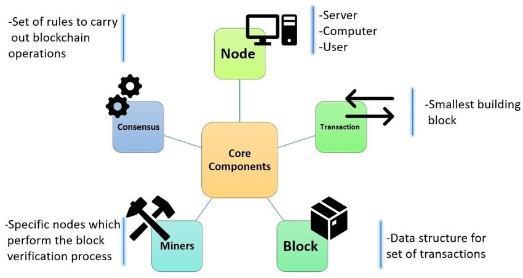What is Blockchain…!!!
Nadia Asghar, Finance Lecturer, Department of Finance
Nowadays when we discuss technology, two terms at the top of the list are blockchain and cryptocurrencies. As everyone is not an IT specialist, this blog will help us to understand what blockchain is and how it works. This technology was first outlined by two mathematicians Stuart and Scott in 1991 and has observed exponential growth in recent times. Blockchain is referred to as an immutable ledger that facilitates the process of recording transactions and tracking assets in a business network. Virtually anything of value can be tracked and traded on a blockchain network.
A simple analogy for how blockchain technology operates can be compared to how a Google Docs document works. When we create a Google Doc and share it with a group of people, the document is simply distributed instead of copied or transferred. This creates a decentralized distribution chain that gives everyone access to the base document at the same time. A significant difference to note however is that unlike Google Docs, original content, and data on the blockchain cannot be modified once written, adding to its level of security. Obviously, blockchain is more complicated than a Google Doc, but the analogy is apt because it illustrates critical ideas of the technology.
Blockchain is complicated but the simplified explanation is detailed below. Blockchain mainly consists of five core components: transaction, block, chains, nodes, and miners (Figure – 1).
- Block: It is the basic unit of a blockchain. Data is stored in it.
- Chain: Blocks inside a blockchain network are connected to each other. Multiple blocks that are joined together form a chain of blocks.
- Node: Nodes are the devices that store these huge amounts of data. Computers, laptops, and big servers function as nodes. All the nodes in a blockchain network are linked together.
- Miners: Individual who create new blocks on the chain through a process called mining. In a blockchain every block has its own unique nonce and hash, but also references the hash of the previous block in the chain, so mining a block isn't easy, especially on large chains.
- Consensus: It is set of agreed rules and regulations to carryout blockchain operations.
Figure – 1

As each transaction occurs, it is recorded as a “block” of data. These transactions show the movement of an asset (tangible / intangible / intellectual). The data block can record the information of our choice, and blocks can be as many as needed. Each block is chronologically connected with the blocks behind and in front of it. When new information is added, a new block is added. These blocks form a chain of data as an asset moves from place to place or ownership changes hands. The blocks confirm the exact time and sequence of transactions, and the blocks link securely together to prevent any block from being altered or a block being inserted between two existing blocks. One of the important features of a blockchain is immutability, which means that any transaction once recorded cannot be altered. The only way to modify is to add the updated data in a new block. Each additional block strengthens the verification of the previous block and hence the entire blockchain. This decreases the possibility of tampering by a malicious actor and builds a ledger of transactions we and other network members can trust.
Blockchain works via a multistep process (Figure – 2), which in simple terms happens as follows:
- An authorized participant inputs a transaction, which must be authenticated by the technology.
- That action creates a block that represents that specific transaction or data.
- The block is sent to every computer node in the network.
- Authorized nodes verify the transaction and add the block to the existing blockchain. (Nodes in public blockchain networks are referred to as miners, who are typically paid for this task, often in a process called Proof of Work (PoW). This payment is usually in the form of cryptocurrency.)
- The update is distributed across the network, which finalizes the transaction.
Figure – 2

A blockchain is a digital ledger or database where encrypted blocks of digital asset data are stored and chained together, forming a chronological single-source-of-truth for the data. Digital assets are distributed, not copied, or transferred. Digital assets are decentralized, allowing for real-time accessibility, transparency, and governance amongst more than one party. Blockchain ledgers are transparent therefore any changes made are documented, preserving integrity and trust. Blockchain ledgers are public and constructed with inherent security measures, making it a prime technology for almost every sector. There are several ways to build a blockchain network. They can be public, private, permissioned, or built by a consortium.
There is a confusion that cryptocurrencies like Bitcoin is the same thing as blockchain. But blockchain is not a coin. It is the underlying technology that enables the bitcoin. Just like an engine which enables a car to move on the road.
Blockchain technology is though hyped as being tamper-less, but it is also vulnerable to cyberthreats. It is observed that blockchain risks and security is compromised due to phishing attacks, code exploitation, routing attacks, stolen keys, sybil attacks, and computer hacking. Therefore, while building an enterprise blockchain application, a comprehensive security strategy that uses cybersecurity frameworks, assurance services and best practices to reduce risks against attacks and fraud is crucial.
Blockchain is a promising and revolutionary technology because it helps reduce security risks, stamp out fraud and bring transparency in a scalable way. Blockchain is already improving the way businesses operate, from banking and finance, agriculture and supply chain, to government, healthcare and education. As a growing number of organisations adopt the technology, blockchain is increasingly becoming a transferable skill. With the crypto workforce predicted to be worth over $68 billion by 2030. It is therefore time to understand it`s importance and figure out how it is related to our present and future.


/prod01/wlvacuk/media/departments/digital-content-and-communications/images-18-19/iStock-163641275.jpg)
/prod01/wlvacuk/media/departments/digital-content-and-communications/images-2024/250630-SciFest-1-group-photo-resized-800x450.png)
/prod01/wlvacuk/media/departments/digital-content-and-communications/images-18-19/210818-Iza-and-Mattia-Resized.jpg)
/prod01/wlvacuk/media/departments/digital-content-and-communications/images/Maria-Serria-(teaser-image).jpg)
/prod01/wlvacuk/media/departments/digital-content-and-communications/images-2024/241014-Cyber4ME-Project-Resized.jpg)
/prod01/wlvacuk/media/departments/digital-content-and-communications/images-18-19/210705-bric_LAND_ATTIC_v2_resized.jpg)